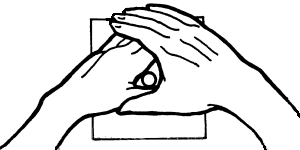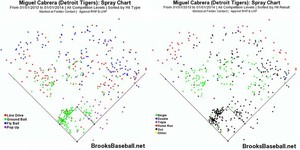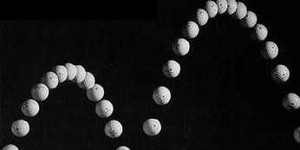Others Like “The Biomechanics of Pitching” (top 20 results)
|
Everyone's used to the idea that people are either right-handed or left-handed for particular tasks. That is, one hand is preferred (or dominant) over the other for a particular task. Did you know that people also have a dominant eye? This project is designed to look for consequences of having the dominant hand and eye on the same side of the body (uncrossed) vs. having the dominant hand and eye on opposite sides of the body (crossed).
Read more
For this project, you'll use a baseball as a pendulum weight, studying the motion of the ball with and without spin. Wrap a rubber band around the ball, and tie a string to the rubber band. Fasten the string so that the ball hangs down and can swing freely. Mark a regular grid on cardboard, and place it directly beneath the ball to measure the motion. You can also time the oscillations with a stopwatch. Lift the ball along one of the grid axes, and let it go. Observe the motion and record…
Read more
So baseball's your game? Well, slugger, science and math abound in baseball. Just look at the zillions of "stats." In this project, you can produce some interesting baseball statistics of your own and perhaps settle a long-standing debate. You'll set up experiments at your local playing field to find out which type of bat is better, wood or aluminum. Play ball, and batter up!
Read more
How high can you throw different types of balls, like a golf ball, a basketball, and a football? Would one of them go higher than the others? Do factors like mass, shape, and volume influence the final height? You can measure the approximate maximum height a thrown ball reaches by measuring the time it spends in the air.
To do this project, you'll need at least one ball and a helper with a stopwatch. Your helper should start timing just as you release the ball, and stop right when the ball…
Read more
Do corked bats really hit the ball further? What about other materials? Here's a project to find out.
Read more
Many sports skills require quick reaction times: think of hitting a 95-mph fastball, returning a 100-mph tennis serve, or blocking a slapshot at the net in hockey. (The Experimental Procedure section below has one way to measure reaction time.) Is your right hand faster than your left? Can you improve your reaction time with practice? Do both hands improve if you only practice with one hand? Try relating your reaction time to real situations in your favorite sport. For example, calculate…
Read more
Are you a piano player or a video gamer? Then you might have a quick reaction time that can come in handy while playing sports. Find out how to measure your reaction time and compare it to your friends and family with this fun experiment.
Read more
In baseball, coaches use hit charts to track the results of every hit each player makes, giving a measure of the player's performance. Have you ever wondered what things affect where a baseball goes when a player hits it with a bat? In this project you will set up an experiment to hit a ping pong ball in a controlled manner using a toy catapult, then learn about the physics of baseball by making your own hit chart.
Read more
Have you ever seen a "Hail Mary" football pass, where the quarterback tries to throw the ball as far as possible to reach the end zone and score a touchdown? Or a last second game tying soccer goal from midfield? How far the ball will go does not just depend on how hard a player throws or kicks it; it also depends on the angle at which the player launches the ball. In this sports science project, you will investigate how launch angle affects the distance that a ball travels by filming…
Read more
Many sports use a ball in some way or another. We throw them, dribble them, hit them, kick them, and they always bounce back! What makes a ball so bouncy? In this experiment you can investigate the effect of air pressure on ball bouncing.
Read more
|
Explore Our Science Videos
Slow Motion Craters - STEM Activity
Solubility Science – STEM Activity
Jumping Candle Flame Experiments – STEM activity









